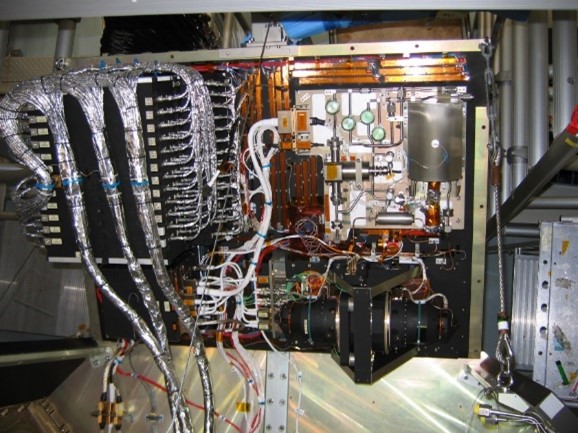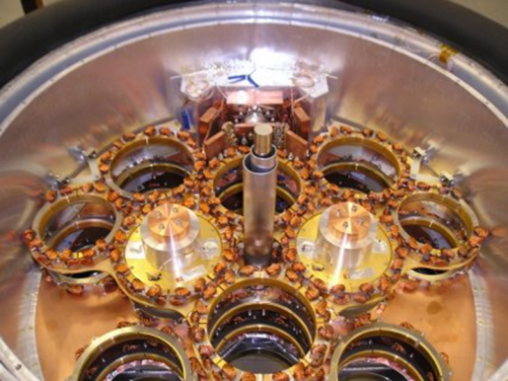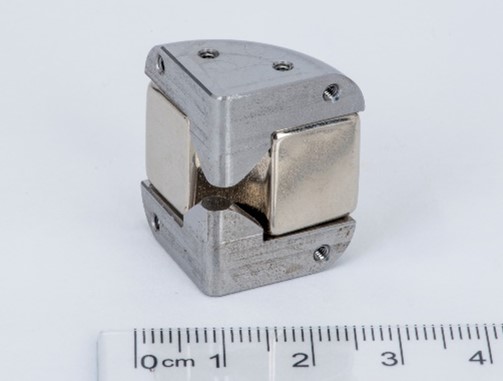 Ariel demonstration model cooler undergoing exported micro-vibration characterisationWe have worked on cooling systems for the Large Hadron Collider and created the most successful closed-cycle cryocoolers ever flown in space, such as that used on the Planck Space Observatory. We have invented basic cryogenic technology components now used as standards worldwide, such as the multifilament superconducting cable known as “Rutherford Cable”. As well as one-off assemblies for individual instruments, we have also produced more than seventy of some units such as the ALMA cryostats for the largest and most sensitive radio telescope in the world.
Ariel demonstration model cooler undergoing exported micro-vibration characterisationWe have worked on cooling systems for the Large Hadron Collider and created the most successful closed-cycle cryocoolers ever flown in space, such as that used on the Planck Space Observatory. We have invented basic cryogenic technology components now used as standards worldwide, such as the multifilament superconducting cable known as “Rutherford Cable”. As well as one-off assemblies for individual instruments, we have also produced more than seventy of some units such as the ALMA cryostats for the largest and most sensitive radio telescope in the world.
Although our work is often hidden, it is ground-breaking enabling technology that cannot be ‘bought off the shelf’, and without which the experiments and observations could not be made.
Closed Cycle Cryocoolers for Space Applications
 The 4K JT-Cooler on the Planck spacecraftWith the launch of ATSR-1 on ERS-1 in July 1991, long-life closed cycle cryocooler technology, supplied by STFC Rutherford Appleton Laboratory, was first realised in space. Since that time STFC has remained at the forefront of the state of the art and our coolers have underpinned a large variety of high-profile scientific and operational missions; ranging from space exploration and the origins of the Universe to Earth observation, climate change and weather forecasting.
The 4K JT-Cooler on the Planck spacecraftWith the launch of ATSR-1 on ERS-1 in July 1991, long-life closed cycle cryocooler technology, supplied by STFC Rutherford Appleton Laboratory, was first realised in space. Since that time STFC has remained at the forefront of the state of the art and our coolers have underpinned a large variety of high-profile scientific and operational missions; ranging from space exploration and the origins of the Universe to Earth observation, climate change and weather forecasting.
Ongoing development has resulted in a range of mechanical cryocoolers covering temperatures from less than 2K to more than 150K. The proven success and reliability of this technology has placed the cryocoolers as being one of the key enabling technologies as ambitions in space evolve. We have licensed the technology to UK and US aerospace industries; the resulting 50-80K product is the most successful European cooler ever to have flown, with more than 130 accumulated years in orbit with no mechanical failures to date.
 An 80K Small Scale Cooler (weighing 600g)
Life and reliability are guaranteed by our flexure-bearing suspension technology which maintains a non-contact, non-lubricated, clearance of 10µm between the moving parts. One life-test cooler has been operated at 40Hz for 19 years (>2.3E+10 cycles) in the laboratory and others have been in operation in orbit for that length of time.
An 80K Small Scale Cooler (weighing 600g)
Life and reliability are guaranteed by our flexure-bearing suspension technology which maintains a non-contact, non-lubricated, clearance of 10µm between the moving parts. One life-test cooler has been operated at 40Hz for 19 years (>2.3E+10 cycles) in the laboratory and others have been in operation in orbit for that length of time.
In addition to space applications, the group is actively involved with applying low power, low mass long-life cooler technology in support of ground-based applications such as developments in quantum technologies.
Cryogenics and Magnetics for Ground-Based Applications
The Cryogenics and Magnetics group also supports a wide range of ground-based astronomy, cosmology, and particle physics experiments, as well as smaller industrial applications. These activities encompass the initial stages of design and modelling through to the manufacture and commissioning of cryogenic, magnetic, and superconducting systems.
Our activities span significant scale in size and quantity; ranging from the design of the proximity cryogenics system for the
ATLAS detector on the Large Hadron Collider at CERN, the development and manufacture of the Hydrogen delivery system for the
Muon Ionisation Cooling Experiment at RAL, the design and production of 70 cryostats for the ALMA observatory down to production of one-off small bespoke superconducting solenoids and design and manufacture of the highly efficient miniature motors used in our cryocoolers.


 The MICE experiment (left), inside an ALMA cryostat (centre), and a small 1T magnet for Diamond Light Source (right)
The MICE experiment (left), inside an ALMA cryostat (centre), and a small 1T magnet for Diamond Light Source (right)
Discover more about our facilities.
Contact us
For enquiries regarding cryogenics and magnetics, please contact
Martin Crook.
